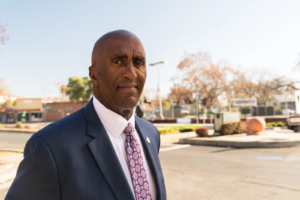hen the long-awaited return of students for in-person classes arrived at Schaumburg High School in late October, Jim Britton sat in his Hyundai Sonata in the school’s parking lot, awaiting his marching orders.
Britton, the director of human resources at Township High School District 211, was among the administrators dispatched to its five high schools as a temporary solution to yet another COVID-19-era conundrum: a serious shortage of substitute teachers at a time when demand has never been higher.
“It’s all hands on deck right now, and our administrators are available to cover classes as needed,” Britton said. “Every day is a challenge, but everyone — our teachers, support staff, principals and secretaries — is making sure that every student is taken care of in all of our buildings.”
A nationwide shortage of substitute teachers was a chronic problem long before the arrival of the pandemic. But now, a dearth of available subs across the Chicago area has reached a crisis level at many school districts, where the roster of educators available to step in when teachers are absent has dwindled precipitously at a time of unprecedented need for their services.
Indeed, the prospect of working as a substitute as the virus continues to rage has discouraged the squad of loyal retired teachers and part-timers who often fill the ranks. Many have told school district officials that the potential health risks are not worth the extra income. That’s happened as the number of teachers and other school employees in quarantine is spiking alongside the latest surge of the virus, only pushing the demand higher.
In response, some districts are stepping up their substitute recruitment efforts to preserve in-person instruction. But others are concluding that remote learning, with all of its flaws, is perhaps the best option, at least until early 2021.
At Schaumburg School District 54, which began the school year with remote learning, students briefly returned to the classroom earlier this fall. But the hybrid plan, which was selected by about 50% of the district’s families, was halted due to both public health and operational metrics, including a rise in COVID-19 rates in the community, and burgeoning numbers of students and teachers in quarantine, district spokeswoman Terri McHugh said.
On Nov. 6, shortly before the pause of in-person learning, 781 students and 158 staff members were in quarantine across District 54′s 28 schools, McHugh said.
“It’s definitely difficult to find substitutes who are willing to work right now, so all of the quarantines did present staffing challenges,” McHugh said.
The district is back to an all-remote plan, and McHugh said recently recruited substitute teachers are being trained on how to deliver virtual lessons to the district’s 15,000 students via educational platforms like Seesaw and Google classroom.
Despite having no reports of COVID-19 transmission at any of the six schools in Wilmette School District 39, the soaring virus rates in Cook County and an increasing number of employees out on quarantine prompted officials to pause their in-person instruction for students in third through eighth grade this month.
District 39 Superintendent Kari Cremascoli said teachers and other employees have worked “incredibly hard“ to mitigate risk and offer a safe and highly effective hybrid learning plan. But unlike illnesses pre-pandemic, which might have meant missing a day or two of work, district employees with COVID-19 symptoms, or who have tested positive or been exposed to the virus, are required by health department guidelines to quarantine for 14 days.
“Pre-COVID, we were already stretched really thin, with not enough subs, but now the need has increased tenfold with all of the restrictions,” Cremascoli said, adding: “On any given day, it’s far more complicated than anyone ever imagined.”
Given the steep challenges school districts are facing trying to find substitute teachers during the pandemic, officials at the Illinois State Board of Education recently launched an emergency program to allow “unlicensed persons of good character” to serve at schools as “supervisors, chaperones or sponsors,” either as volunteers or for pay, during the declared public health emergency, ISBE spokeswoman Jackie Matthews said in a statement.
The emergency rules, which are helpful when teachers have to quarantine at home, allow the unlicensed person to supervise students in a classroom under the guidance of a teacher who is delivering lessons remotely or other licensed personnel physically present in the building, Matthews said.
Candidates applying for a substitute license in Illinois must have a bachelor’s degree or higher, and pay a $50 fee, which is reimbursed by the state after teaching 10 or more days after receiving a license, according to the ISBE website. While pay rates typically range from about $110 to $120 a day, long-term substitutes can earn up to $200 a day at some districts.
Now many districts have stepped up social media pushes and advertising to try to draw more candidates.
Officials at New Trier High School recently hired a team of classroom supervisors — many of them parents in the community — to keep watch over students who are immersed in remote learning from the classroom, director of human resources Renee Zoladz said.
While Zoladz said about 80% of New Trier’s teachers are instructing students in person at the high school’s campuses in Winnetka and Northfield, the classroom supervisors — who earn about $35 an hour — allow teachers who are on quarantine, or who have received medical accommodations, to deliver remote lessons from home.
“We always have a pool of substitutes who are retirees, but right now, many are just not comfortable being in a classroom with students, and they’re putting off returning until there is a vaccine,” Zoladz said.
On a recent morning in Arlington Heights School District 25, there were 111 absences across the district’s nine schools. Of those, 47 spots would be filled by administrators, including principals, leaving 64 posts in need of substitute teachers, said Brian Kaye, the assistant superintendent of personnel and planning.
While the district was able to round up 35 substitutes, minutes before classes started Kaye was scrambling to fill the remaining 29 positions by reassigning teacher assistants and dispatching administrators at the district headquarters to school buildings in need.
Kaye said the required quarantines have certainly had an impact on staffing classrooms, but the issue is not primarily a matter of increased teacher absences — it’s a shrinking pool of substitutes due to coronavirus concerns.
“Most of our loyalist substitutes have shared openly that they are absolutely more concerned about being around kids right now, and they say they plan to come back once there’s a vaccine,” Kaye said.
To be sure, even substitutes who are willing to teach students in person are facing new challenges this year, in particular, learning how to handle the rigors of delivering in-person lessons in the classroom, alongside synchronous, remote instruction, Kaye said.
“Without a doubt, subbing today means teaching the ‘roomies’ and the ‘Zoomies,’ which requires quite a bit of training,” Kaye added, referring to students in the classroom and those doing remote learning.
Of course, the role of the substitute teacher has always been fraught with perils, as students typically view the stranger in the classroom as both lacking authority and the perfect foil for practical jokes, said Lisa Burke, a professor and chairwoman of the Department of Education at Elmhurst University.
“Substitutes don’t make a lot of money, about $120 a day, and then they get in a classroom where the kids are unruly, and they realize that they’re unfamiliar with the content they’re supposed to be teaching,” Burke said. “Unless they’re certified teachers, they have no background with classroom management, and they might not remember the math. And there are not a lot of people out there who have lots of experience handling 25 kindergartners.”
While some substitutes are retired teachers with decades of experience in the classroom, many are part-time workers who mistakenly assume that teaching will be an extension of parenting, Burke said.
“Teaching isn’t a natural skill, and if you haven’t had any preparation in the pedagogy of teaching, you’re going to find working as a substitute can be very difficult,” Burke said.
“The missing piece is, subs aren’t regular teachers, and unless they’re prepared with training, many of them are not going to go back, because even six hours can really drag on if the students are not listening,” Burke said.
Still, Burke acknowledged that enrolling in a few rudimentary education courses at a local college, while highly valuable, might be prohibitive for many substitute teachers who, after all, are seeking the work to earn extra cash.
“It’s a conundrum with wide-spreading implications,” Burke said of the lack of qualified substitute teachers, as well as the growing teacher shortage across the U.S.
Nevertheless, the ramped-up substitute teacher recruitment at suburban Chicago school districts in recent months has been serendipitous for some new hires, like Hoffman Estates resident Shonda Dudlicek.
“I’m really happy to have this opportunity, and I kind of wish I had started subbing years ago,” said Dudlicek, a longtime journalism instructor at Roosevelt University in Chicago, who has been busy working as a District 54 substitute teacher since the start of the school year.
On Thursday, Dudlicek and her husband and teenage daughter were home recovering from a recent bout with COVID-19. But with just a few days of quarantine left, Dudlicek was able to carry on with her new role as a substitute teacher, delivering remote lessons to students via Zoom.
“Remote learning has been hard for everyone in so many different ways, but the teachers are amazing, and the kids have been so patient with me,” Dudlicek said. “All of this has given me a fascinating perspective for teaching my college students. And I’m learning so much from these kids, it’s just an incredible experience.”




